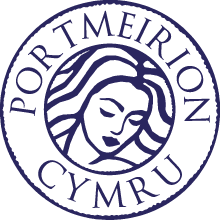
The beautiful Portmeirion Village was built by Welsh architect Clough Williams-Ellis from 1925 to 1973.
"Clough hoped that his work at Portmeirion would inspire others."
In 1925, Welsh architect Clough Williams-Ellis acquired the site which was to become Portmeirion. He had been searching for a suitable site for his proposed ideal village for several years and when he heard that the Aber Iâ estate near Penrhyndeudraeth was for sale, he did not hesitate to make an offer.
He wanted to show how a naturally beautiful location could be developed without spoiling it, and that one could actually enhance the natural background through sympathetic development. The Aber Iâ estate had everything he had hoped for as a site for his architectural experiment: steep cliffs overlooking a wide sandy estuary, woods, streams and a nucleus of old buildings.
But the history of Portmeirion started long before 1925. The construction of Castell Deudraeth was recorded in 1188 by Gerald of Wales, who wrote: "We crossed the Traeth mawr and the Traeth Bychan. These are two arms of the sea, one large and one small. Two stone castles have been built there recently. The one called Castell Deudraeth belongs to the sons of Cynan and is situated in the Eifionydd area, facing the northern Mountains."
Castell Deudraeth was referenced again by the 17th century philologist, geologist, natural historian and keeper of the Ashmolean Museum in Oxford, Edward Lhuyd in 1700. Lhuyd recorded the name as Aber Iâ, stating " The Castle of Aber Iâ yet stood in ruined form overlooking the south western extremity of the peninsula".
In 1861, Richard Richards wrote a description: "Neither man nor woman was there, only a number of foreign water-fowl on a tiny pond, and two monkeys, which by their cries evidently regarded me as an unwelcome intruder. The garden itself was a very fine one, the walls of which were netted all over with fruit trees...Aber Iâ, then, gentle reader, is a beautiful mansion on the shore of Traeth Bach, in Merionethshire."
When Williams-Ellis acquired the land in 1925 he wrote, "a neglected wilderness - long abandoned by those romantics who had realised the unique appeal and possibilities of this favoured promontory but who had been carried away by their grandiose landscaping...into sorrowful bankruptcy." Clough immediately changed the name from Aber Iâ (Glacial Estuary) to Portmeirion; Port because of the coastal location and Meirion as this is Welsh for Merioneth, the county in which it lay.
His first job was to extend and convert the old house on the shore into a grand hotel. The concept of a tightly grouped coastal village had already formed in Clough's mind some years before he found the perfect site and he had quite a well-defined vision for the village from the outset.
Portmeirion was built in two stages: from 1925 to 1939 the site was 'pegged-out' and its most distinctive buildings were erected. From 1954-76 he filled in the details. The second period was typically classical or Palladian in style in contrast to the Arts and Crafts style of his earlier work. Several buildings were salvaged from demolition sites, giving rise to Clough's description of the place as "a home for fallen buildings".
"An architect has strange pleasures," Clough wrote in 1924. "He will lie awake listening to the storm in the night and think how the rain is beating on his roofs, he will see the sun return and will think that it was for just such sunshine that his shadow-throwing mouldings were made."
The first article about Portmeirion appeared in The Architects' Journal (January 6 1926) with photographs of scale models and preliminary designs prepared by Clough to impress potential investors. In this article, John Rothenstein writes: "On the sea-coast of North Wales, quite near his own old home, Plas Brondanw, he has acquired what he believes to be an ideal site, and he is engaged upon plans and models for the laying out of an entire small township. The results of his scheme will be significant and should do much to shake the current notion that although houses must be designed with due care, towns may grow up by chance."
The Hotel Portmeirion officially opened for the Easter Weekend, on 2nd April 1926. The last building, the Tollgate, was built in Clough's 93rd year.












